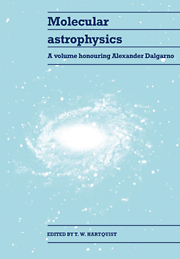Book contents
- Frontmatter
- Contents
- Dedication
- Preface
- Part I Molecular clouds and the distribution of molecules in the Milky Way and other galaxies
- Part II Diffuse molecular clouds
- Part III Quiescent dense clouds
- Part IV Studies of molecular processes
- Part V Atomic species in dense clouds
- 14 Observations of atomic species in dense clouds
- 15 Ultraviolet radiation in molecular clouds
- 16 Cosmic ray induced photodissociation and photoionization of interstellar molecules
- 17 Chemistry in the molecular cloud Barnard 5
- 18 Molecular cloud structure, motions, and evolution
- Part VI H2 in regions of massive star formation
- Part VII Molecules near stars and in stellar ejecta
- Part VIII Moderately ionized gas and chemistry at large redshifts
- Index
16 - Cosmic ray induced photodissociation and photoionization of interstellar molecules
Published online by Cambridge University Press: 10 December 2009
- Frontmatter
- Contents
- Dedication
- Preface
- Part I Molecular clouds and the distribution of molecules in the Milky Way and other galaxies
- Part II Diffuse molecular clouds
- Part III Quiescent dense clouds
- Part IV Studies of molecular processes
- Part V Atomic species in dense clouds
- 14 Observations of atomic species in dense clouds
- 15 Ultraviolet radiation in molecular clouds
- 16 Cosmic ray induced photodissociation and photoionization of interstellar molecules
- 17 Chemistry in the molecular cloud Barnard 5
- 18 Molecular cloud structure, motions, and evolution
- Part VI H2 in regions of massive star formation
- Part VII Molecules near stars and in stellar ejecta
- Part VIII Moderately ionized gas and chemistry at large redshifts
- Index
Summary
Introduction
The interior of a dense molecular cloud is efficiently shielded from the ultraviolet photons of the interstellar radiation field by the grains. Accordingly, the effects of the ultraviolet photons on the physical and chemical states of dense clouds are in general, neglected. However, several internal sources of ultraviolet photons may be present, including the emission from embedded stars and internal shocks driven by mass loss from young stars. Here the discussion is focused on a diffuse source of internal ultraviolet photons arising from energetic cosmic rays capable of penetrating dense clouds. Cosmic ray particles with energies between 10 and 100 MeV ionize molecular hydrogen in the interior of the clouds and generate secondary electrons with a mean energy of around 30 eV (Cravens and Dalgarno 1978). Because the fractional ionization is generally low, the secondary electrons degrade mainly through excitations of various electronic states of H2. Typical excitation energies are 10–15 eV. Ionization of H2 by the secondary electrons may also occur. The subsequent decays of the electronically excited states of H2 produce ultraviolet photons within the clouds.
The idea of molecular hydrogen emission inside dense clouds was invoked by Prasad and Tarafdar (1983) to explain the large abundance of atomic carbon which exists in several molecular clouds. Observations of emission in the 3P1–3P0 and 3P2–3P1 fine-structure lines of neutral atomic carbon in dense interstellar clouds (Phillips and Huggins 1981, Keene et al. 1985, Zmuidzinas, Betz and Goldhaber 1986) have demonstrated the existence of C with abundances relative to CO exceeding 0.1.
- Type
- Chapter
- Information
- Molecular AstrophysicsA Volume Honouring Alexander Dalgarno, pp. 305 - 312Publisher: Cambridge University PressPrint publication year: 1990
- 6
- Cited by

